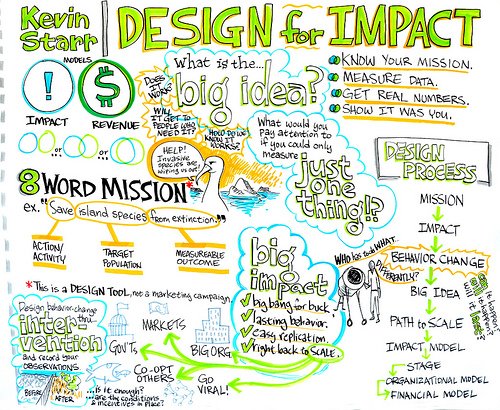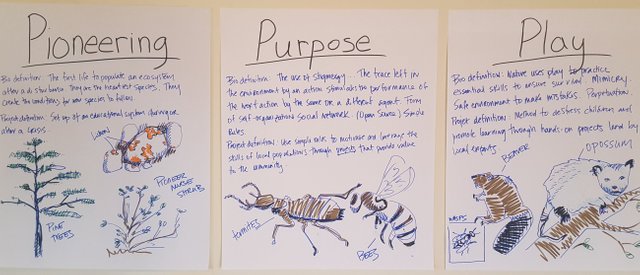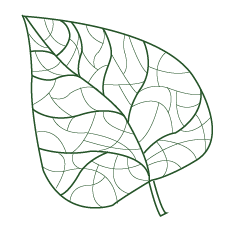Designing the Organizations and Social Innovations of Tomorrow
The farther down the Biomimicry and Plant Intelligence rabbit hole I go, the more I see the elegant--and often simple--solutions nature has found to complex problems. While not exactly the same, there are many parallels to be found between problems in nature and man-made problems. The question I keep asking myself is:

In some areas, the road seems clear. The EU put out the 2018 Circular Economy Package that calls for all plastics packaging to be recyclable by 2030 and additional legislative proposals on waste of every type, from electronic to industrial. Everything needs to start with an end-of-life plan1. Solutions to these types of problems are abundant in nature. And from what I am seeing, there are some great minds working on the physical development of nature-based and nature-inspired solutions.
In case you are curious, I separated out nature-based and nature-inspired, because they are not exactly the same thing. In the former, nature itself is part of the solution, such as the creation of a constructed wetland to purify water. In the latter, you are basing the design of your solution on how nature would carry out a given function. This is what you do in biomimicry and bionics.

Image by Poptech (CC BY-SA 2.0)
Organizations and Social Innovations
Back to the paths... in some cases, the path is more unclear. This is especially true when looking for social innovations. It is easy to look to nature for something physical, but it takes a shift in your thinking to extrapolate a process or a program.
Ever attracted to the big problems, of course it is social innovations that excites me the most. The first time I worked on a biomimetic solution to a problem, we were asked to design an educational system that could be activated in times of war or natural disaster. When a city goes into emergency mode, schools are the first things to shut down. Yet when the rebuilding efforts take years, not months, you can't just forget about the kids in that time. Children keep growing, and if they are going to become productive adults, they need to keep learning. Not only, parents need time to focus on their own rebuilding, making school and good child-care a necessary relief.
After lots of thinking and churning, our solution identified three organisms in nature to mimic:

My Image
- Pioneer plant species--such as the pine--the first predictable seeders, adaptable to many conditions and the most vigorous flora to colonize disturbed or damaged ecosystems2.
- How beavers raise their kits (a "kit" is a baby beaver).
- Stigmergy, a self-organizing biological process where a trace left in the environment by an action stimulates the performance of a next action, by the same or a different agent3
In a nutshell, our program, titled "Raising Sprouts", mimicked the nurturing environment created by the pioneer tree to self-organize pop-up learning environments in central locations where in the first phase, older generations that could not physically contribute to the rebuilding could taking care of the children. As the area became more stable, mimicking the beaver's hands-on approach, children could then shadow adults in different trades to learn while doing. Each group contributed independently to the overall education process, which would ensure a continuation of learning activities so that children could easily transition back into traditional schools once they were operational again.
For a first attempt, we were pretty proud of our idea, especially since it was really hard to get to. Personally, all the research to create our function cards made me realise the rich examples of self-organisation nature has to offer! I was stimulated by all the examples of complex, yet highly functional and relatively easy organizational structures we studied, beyond the obvious ants and termites. Plants and animals rely more heavily on each other for their survival, so it makes sense that those that continue to exist have developed efficient solutions for how to work together, teach the next generation, produce multifaceted results, and everything necessary to guarantee evolutionary sustainability.

Pixabay (CC0 Creative Commons)
Helping You Design A Nature-Inspired Organization
Since that first experience, I have gone on to train and work with a variety of nature-inspired innovation processes, including my masters and grant-based projects. They come together in the Circular Innovation Design Process we are pioneering as Bioversum - Nature Inspired Systems.
I would like to expand my facilitation to include this work, so I have been developing a new program. Can you look it over and give me your feedback?
Below is the first draft. Can you read through it and answer the following questions:
- Without any context, just reading it, what do you think it is for? What would be the outcome from doing this program?
- Based on your experience, who would it appeal to? A corporation, small business, individual, group...?
- What do you think of the title? If you don't like it, any suggestions?

Organizational Sustainability Inspired by Nature
Your business is not performing, your program isn't working. You have all the best people, so what is the problem?
Organizational structures and relationships that once encouraged competition, today create silos of mistrust. Modern business success requires transdisciplinary partnerships and agile organizations capable of finding solutions across domains.
And you know who has been creating these types of systems for 3.8 billion years?
Nature.
Living organisms have evolved strategies to continually develop and adapt to changing conditions. Many of the challenges your business is facing have already been solved by the natural world. Looking to nature, we can find patterns to survive and thrive on Earth, sustaining a circular way of doing business that encourages collaboration and creative problem solving. Biological design is resilient, adaptable, multifunctional, and regenerative. Who better to learn from?!
With Tigrilla Gardenia's guidance, discover how to optimize teams and best use their talents by modeling your organization on the genius of nature.
Tigrilla uses her love of speaking, analytical mind, communications expertise, and gamification experience to design cross-functional team development inspired by nature. Her background in plant intelligence, cognition, and neurobiology and working with nature-based systems such as biomimicry layers perfectly over her ample experience in corporate developing projects and structures from high-tech to the arts.
Give your organization the original antidote to stress and lack of creativity: using a Circular Innovation Design Process rooted in practical and theoretical experience with the plant world, create a work environment that functions as efficiently and cohesively as a forest.

Your Thoughts?
Thank you for taking the time to answer the questions, this will really help me. And if you know of any conference or organization looking for a dynamic speaker or facilitator, please pass them my information: www.tigrillagardenia.com.
Thank you!

Follow Tigrilla - @yvesoler - for more about
Plant Intelligence/Cognition/Neurobiology and Biomimicry
SPEAKER | FACILITATOR | NATUREPRENEUR
Facilitating evolutionary Interspecies Communication to CoCreate Nature-Inspired Places, Products, and Processes.
Want to know more?
Plant neurobiology, biomimicry, social innovation, plant music, design, interspecies communication, urban planning... These are just some of the biophilic topics I cover on my website and here on Steemit. Follow along and comment often. My goal is to create discussion, not give a conference! And if you explore related topics, let me know in the comments, I would love to follow you.
Made a few changes to the description based on feedback I am receiving. Here is a second draft:
Collaborative Teams Inspired by Nature
Discover a natural framework to stimulate teamwork across boundaries
Your business is not performing. You have all the best people, so what is the problem?
Organizational structures and relationships that once encouraged competition, today create silos of mistrust. Modern business success requires transdisciplinary partnerships and agile organizations capable of finding solutions across domains.
And you know who has been creating these types of systems for 3.8 billion years?
Nature.
Living organisms have evolved strategies to continually work as a team to develop and adapt to changing conditions. Many of the challenges your business is facing have already been solved by the natural world. Looking to nature, we can find patterns to survive and thrive on Earth, sustaining a circular way of working together that encourages collaboration and creative problem solving. Biological design is resilient, adaptable, multifunctional, and regenerative. Who better to learn from?!
With Tigrilla Gardenia's guidance, discover how to optimize organizational structures, build a cohesive team, and best use their talents by modeling your organization on the genius of nature.
Tigrilla uses her love of speaking, analytical mind, communications expertise, and gamification experience to design cross-functional team development inspired by nature. Her background in plant intelligence, cognition, and neurobiology and working with nature-based systems such as biomimicry layers perfectly over her ample experience in corporate developing projects and structures from high-tech to the arts.
Give your team the original antidote to stress and lack of creativity: using a Circular Innovation Design Process rooted in practical and theoretical experience with the plant world and biomimicry, create a work environment that functions as efficiently and cohesively as a forest.
So.... what do you think?